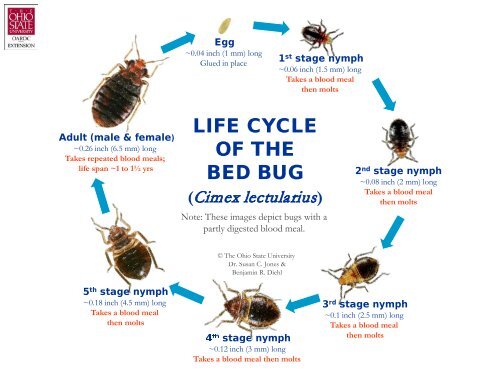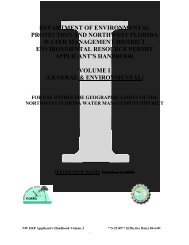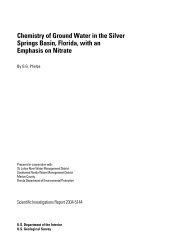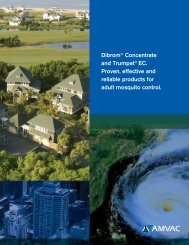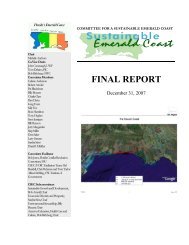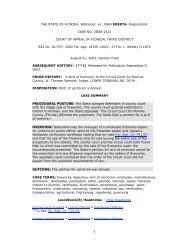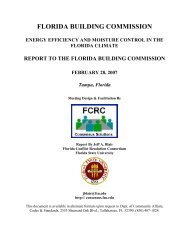Cimex lectularius
Cimex lectularius
Cimex lectularius
- No tags were found...
You also want an ePaper? Increase the reach of your titles
YUMPU automatically turns print PDFs into web optimized ePapers that Google loves.
American Entomologist, Spring 2011
The Bed Bug Has Not Changed• But we havefor a Long Timehttp://neuroethicscanada.files.wordpress.com/2009/12/6f81c.jpg
It’s hard to get a handle onnumbers
The places we're finding them,global89%88%67 (80%)5% 4 (19%)10 (36%)17 (36%)31%12 (31%) 24 (46%)35 (54%)Also, churches, day cares, libraries, summer camps, hostels, furniture and retail stores,restaurants, locker rooms, dressing rooms, prisons, fire and police stations, moving vans,ambulances, funeral homes, doctor’s offices, and dialysis clinics.NPMA Bugs without Borders, Potter et al. 2010
United States
• Requests for informationthrough Dean Dusky’soffice to all counties• 47 of 67 countiesresponded• Feb 26-Mar 14, 2011• Requests for informationper month• Gray, 0• Yellow, 1-4• Orange, 2-8• Purple, 3-12• Dark red, 6-12• Bright red, 11-15
MUVE HighlightsUrban Entomology 2011Steven M. VallesUSDA-ARSCenter for Medical, Agricultural andVeterinary EntomologyGainesville, Florida
Number of stories (2011)3500300025002000150010005000Urban Termites Cockroaches Bed bugs AntsUrban entomology and associated pestsPOPULAR PRESS
Number of hits120010008006004002000NAL Pubmed WWSUrban Bedbug Termite Cockroach Ant Ant/pestUrban entomology and associated pestsSCIENTIFIC PRESS
Research Highlights
Genome/transcriptomesequencing of urban insect pests20111. Bed bug, <strong>Cimex</strong> <strong>lectularius</strong> (2 studies)2. Caribbean crazy ant, Nylanderia pubens3. Argentine ant, Linepithema humile4. Red imported fire ant, Solenopsis invicta5. Red harvester ant, Pogonomyrmex barbatus6. Carpenter ant, Camponotus floridanus7. Jumping ant, Harpegnathos saltator8. Leafcutting ant, Atta cephalotes9. German cockroach, Blattella germanica
Bed bug, <strong>Cimex</strong> <strong>lectularius</strong>HIGHLIGHTS• Pesticide resistance pathways• Wolbachia present• Pesticide resistance genes• Up-regulated in pesticideexposed bugs• P450/GST• SNP/microsatellitesOmprakash MittapalliOhio State University
Bed bug, <strong>Cimex</strong> <strong>lectularius</strong>HIGHLIGHTS‡ Source material: Insecticidesusceptible and pyrethroidresistantbedbugs (5200-fold)‡ Cytochromes P450, GSTs, andcarboxylesterases significantlyoverexpressed in resistant bugs‡ Specific isozymes of eachclass of the detoxificationenzymes were identified‡ Multiple resistancemechanismsZach Adelman & Dini MillerVirginia Tech
Bed bug, <strong>Cimex</strong> <strong>lectularius</strong>Detoxification enzyme gene expression and abundanceZach Adelman & Dini MillerVirginia Tech
Bed Bug Chemical EcologyHIGHLIGHTS• Antennal morphologyand volatile emission issimilar to C. <strong>lectularius</strong>• Two chemicals areemitted by adults andnymphs under stress(hexenal and octenal),but at different ratios• Nymphs emit twounique chemicals• Nymph pheromonecould find applicationfor controlJette KnudsenLund University, Sweden
Clinical Infectious Diseases 52(2): 200 (2011)Review: BedbugsHIGHLIGHTS• Reviews the entomology,epidemiology and medical impact ofbedbugs• Describe 45 candidate pathogenspotentially transmitted by bedbugs,according to their vectorial capacity,inthe wild, and vectorial competence,in the laboratory⇝Statements about the ability tovector Chagas’ disease evoked aresponse from Jerome Goddard(Clinical Infectious Diseases 53(2):210)Pascal DelaunayUniversite´ de Nice-Sophia AntipolisFrance
Marc RomneySt. Paul’s HospitalVancouver, CanadaEmerging Infectious Diseases 17: 1132 (2011)HIGHLIGHTS1. Three patients from an impoverished community in Vancouver with high rates ofhomelessness, poverty, HIV/AIDS, and injection drug use were found infested withbedbugs2. Hypothesized that these parasites may be vectors for the transmission ofantimicrobial drug–resistant pathogens3. Antibiotic resistant bacteria (MRSA and VRE) were detected in these bedbugs4. Bedbugs may act as a hidden environmental reservoir for MRSA and maypromote the spread of MRSA in impoverished and overcrowded communities
Pest Management Science 67: 734 (2011)HIGHLIGHTS• Insecticideevaluations againstthe tropical bed bug• Differentdevelopmentalstages wereexamined• InsecticiderecommendationsmadeChow-Yang LeeUniversiti Sains Malaysia
HIGHLIGHTS• Multiplex polymerase chain reaction wasdeveloped to distinguish bed bug eggs, legfragments, and degraded samples from otherarthropods that frequently occur in humandwellings• This method provides a reliable techniquefor identifying C. <strong>lectularius</strong>, whenmorphological identification is not possibleAllen SzalanskiUniversity of Arkansas
Bed bug monitoringHIGHLIGHTS• Evaluated 3 monitors (withattractants)• CDC3000• NightWatch• Home-made trap withdry ice• Relative effectiveness:Dry-ice trap>CDC3000>NightWatch• Monitors are effective toolsin detecting early bedbuginfestationsContributed by:Changlu WangRutgers
Bed bug<strong>Cimex</strong> <strong>lectularius</strong>HIGHLIGHTS• Bed bug populationsincreasing• Pesticide resistance• Increased travel• Rooms with moreclutter• Greater prevalence ofbed bug-friendlyfurnishings• Pyrethroids most widelyused• Pyrethroid resistance inFL, CA, OH, VA, KY• At least one state hasrequested an emergencyexemption from the EPAto use propoxur
Contact InformationFaith M. OiUniversity of FloridaEntomology and Nematology Dept.Gainesville, FL 32611foi@ufl.edu


